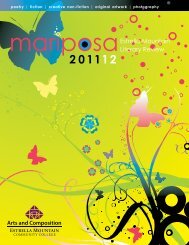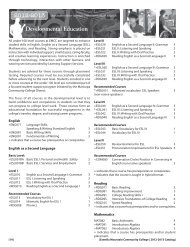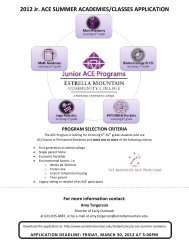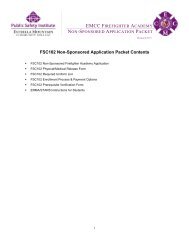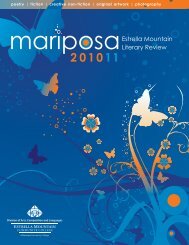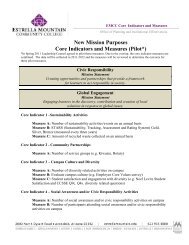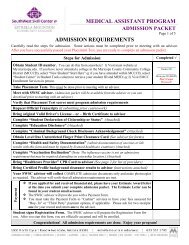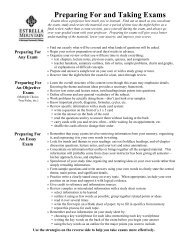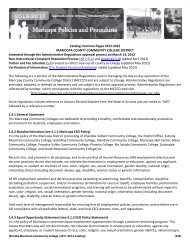EMCC Learning Case Study - Estrella Mountain Community College
EMCC Learning Case Study - Estrella Mountain Community College
EMCC Learning Case Study - Estrella Mountain Community College
You also want an ePaper? Increase the reach of your titles
YUMPU automatically turns print PDFs into web optimized ePapers that Google loves.
<strong>Estrella</strong> <strong>Mountain</strong><br />
<strong>Community</strong> <strong>College</strong><br />
To optimize the learning experience, <strong>Estrella</strong> <strong>Mountain</strong><br />
<strong>Community</strong> <strong>College</strong> experimented with two “<strong>Learning</strong><br />
Studios”—classrooms that integrate highly mobile furniture,<br />
technology, and an attractive use of color to create a<br />
stimulating, adaptable space. A blend of elements from the<br />
Resolve System and the Intersect Portfolio, Caper chairs, and<br />
Avive tables was part of the college’s successful solution.<br />
EDUCATION/LIBRARY;<br />
AVONDALE, ARIZONA<br />
Topic:<br />
Change<br />
Technology<br />
Application:<br />
Formal <strong>Learning</strong><br />
Internet/Electronic Access<br />
Project Scope:<br />
32 students per classroom;<br />
2 <strong>Learning</strong> Studio classrooms;<br />
900 square feet per classroom<br />
Herman Miller Product:<br />
Resolve ® System<br />
Caper ® Chairs<br />
Avive ® Table Collection<br />
The Intersect ® Portfolio<br />
Year Completed:<br />
2005<br />
z <strong>Case</strong> <strong>Study</strong> / 2005
What will the higher education classrooms of tomorrow look like? Arizona’s <strong>Estrella</strong> <strong>Mountain</strong><br />
<strong>Community</strong> <strong>College</strong> (<strong>EMCC</strong>) may have a head start on defining that vision.<br />
<strong>EMCC</strong>, situated in western metropolitan Phoenix, is a member of the Maricopa <strong>Community</strong><br />
<strong>College</strong> District, the nation’s largest. Expanding to keep pace with regional growth, <strong>EMCC</strong><br />
is challenged with serving a diverse student population—some tech-savvy, some juggling<br />
classes, families, and jobs, and some attending for specific job training.<br />
In 2005, <strong>EMCC</strong> partnered with Herman Miller and its local dealer, Goodmans Interior<br />
Structures, to rethink the classroom environment. The team set out to convert two of the<br />
college’s conventional liberal arts classrooms into prototype “<strong>Learning</strong> Studios” designed<br />
to maximize the student/teacher experience.<br />
<strong>EMCC</strong> follows three main principles in developing campus spaces: leverage of physical<br />
space; engagement of stakeholders; and a concept its leadership calls “radical flexibility,”<br />
an approach that frees faculty and students to customize classroom space to meet their<br />
teaching and learning needs.<br />
Beyond the obvious motivation to improve the educational experience, <strong>EMCC</strong> had a few<br />
added incentives. Results of a recent student focus group and survey on classroom design<br />
placed the use of space, aesthetics, and moveable furniture at the top of the list of concerns.<br />
Most importantly, the college wanted to set a different standard as it prepared to launch a<br />
significant new construction project.<br />
The <strong>Learning</strong> Studios initiative offered the college, Herman Miller, and Goodmans the<br />
opportunity to experiment with space—including color and light—furniture, and technology.<br />
From the beginning, the studios were envisioned as active learning spaces designed to<br />
adapt easily to their users’ needs at any time.<br />
The team considered a multitude of approaches to re-imagining the modern educational<br />
environment. Elements of Herman Miller’s Resolve system and Intersect portfolio, as well as<br />
Caper seating and Avive tables, provided the flexibility, mobility, and ergonomics desired to<br />
create a fluid, dynamic setting. The infrastructure was designed to accommodate adaptable<br />
lighting, ready access to electrical power, and wireless technology. Throughout both studios,<br />
z <strong>Estrella</strong> <strong>Mountain</strong> <strong>Community</strong> <strong>College</strong> <strong>Case</strong> <strong>Study</strong> / 2
attention was given to creating a stimulating space through the use of an inviting palette of colors,<br />
textures, and finishes conducive to supporting an effective teaching and learning experience.<br />
In terms of specifics, the <strong>Learning</strong> Studios feature tools such as wall writing and projection<br />
surfaces throughout the space; mobile teaching stations; and wireless laptop computers<br />
to open up desk space and sight lines. These and other amenities serve <strong>EMCC</strong>’s radical<br />
flexibility paradigm by supporting small-group dynamics and collaborative learning.<br />
And the reaction from faculty and students?<br />
“The faculty provided a lot of input on the <strong>Learning</strong> Studio prototypes and once the studios were<br />
ready, they actively participated to see what worked,” says E-<strong>Learning</strong> Faculty Coordinator<br />
Polly Miller. “Instructors liked the size of the classrooms and felt the openness and choice of<br />
colors helped create a relaxing, emotionally safe space. They also liked that technology was<br />
everywhere, but not in the way. They felt it fostered a very fluid environment and enhanced<br />
overall communication. Their feedback helped validate the success of the studio experiment.<br />
“Similarly, the student reaction was very positive. Students feel ‘valued’ because of what the<br />
college did to improve the learning environment and as a result behave more professionally<br />
in the studio setting.”<br />
Dr. Roger Yohe, faculty director of <strong>EMCC</strong>’S Center for Teaching and <strong>Learning</strong>, adds, “The<br />
<strong>Learning</strong> Studio environment really empowers our students. In the traditional classroom model,<br />
‘don’t move the furniture’ is the rule. In the <strong>Learning</strong> Studios, we say, ‘please move the furniture.’<br />
By enabling learners to experiment with radical flexibility, we are creating a whole new mindset.”<br />
<strong>EMCC</strong> Dean of Academic Affairs Joyce M. Jackson sums it up: “It’s important to make learning<br />
spaces intuitive for faculty and students and create environments that encourage learning,<br />
collaboration, and socialization. <strong>College</strong>s and universities need to make a commitment to<br />
design space and infrastructure in ways that ensure student success.”<br />
<strong>EMCC</strong> is well on its way to achieving meaningful change. Its newest building project,<br />
Ocotillo Hall, includes 22 new <strong>Learning</strong> Studios designed directly from the feedback and<br />
concepts of these original prototypes.<br />
A. 32 students in break-out groups<br />
with computers.<br />
B. 32 students at computers—alternate front<br />
of the rooom.<br />
C. 32 students at computers.<br />
© 2010 Herman Miller, Inc., Zeeland, Michigan<br />
® L, Avive, Caper, Intersect, and Resolve are<br />
among the registered trademarks of Herman Miller, Inc.<br />
z <strong>Estrella</strong> <strong>Mountain</strong> <strong>Community</strong> <strong>College</strong> <strong>Case</strong> <strong>Study</strong> / 3<br />
A.<br />
B.<br />
C.



